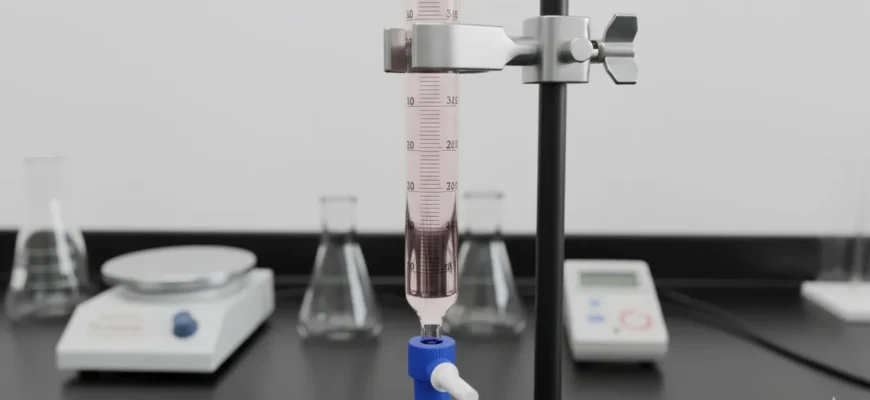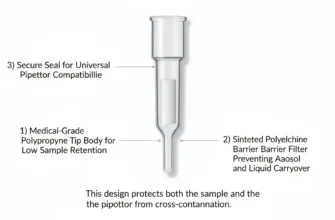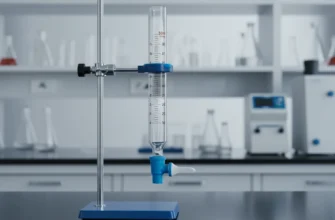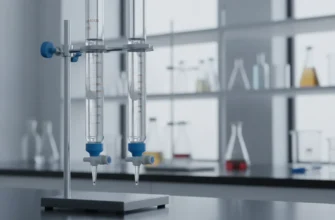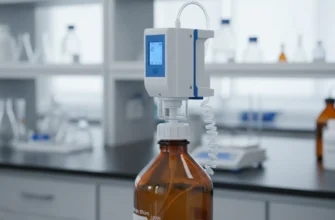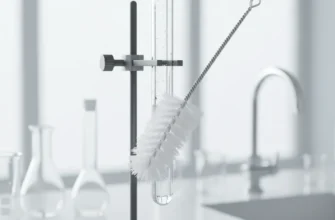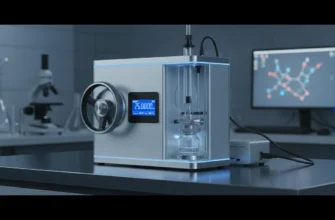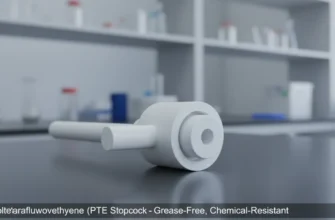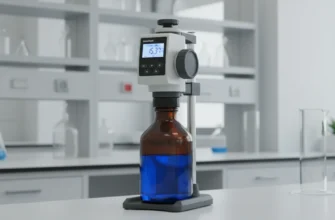Understanding the Graduated Burette
A graduated burette is a precision volumetric glassware instrument used in analytical chemistry to dispense variable volumes of liquid with high accuracy, primarily for titrations where controlled addition of reagents is essential. It features a long glass tube with etched volume graduations and a stopcock for flow regulation, distinguishing it from fixed-volume tools like pipettes.
Key Highlights
Graduated burettes enable precise liquid delivery in quantitative analysis, supporting reactions that determine concentrations or reaction endpoints. They are constructed from borosilicate glass for resistance to chemicals and thermal shock, with capacities typically ranging from 10 mL to 100 mL. Calibration marks provide subdivisions of 0.10 mL, and stopcocks—often made of PTFE—allow drop-by-drop control to minimize errors. Burettes are classified as Class A for superior accuracy in professional settings or Class B for general use, with tolerances like ±0.05 mL for a 50 mL Class A model. Proper meniscus reading at eye level and routine cleaning with deionized water ensure reliable measurements.
Introduction
In laboratory environments, precision tools like the graduated burette are crucial for quantitative experiments where even minor volume errors can skew results. Unlike basic glassware such as beakers or graduated cylinders, burettes offer the fine control needed for advanced techniques like titration, making them indispensable in analytical chemistry for measuring unknown concentrations through controlled reagent addition.
What Is a Graduated Burette?
A graduated burette is a vertical glass tube equipped with volume markings along its length and a stopcock valve at the bottom to regulate liquid flow. This design facilitates the delivery of precise, adjustable volumes of liquid, up to the burette’s full capacity, which sets it apart from pipettes that handle only fixed amounts. Its core application lies in titrations, where gradual addition of a titrant to an analyte allows detection of the equivalence point, enabling accurate concentration calculations.
Defining the Graduated Burette in Laboratory Settings
In labs, a graduated burette serves as a volumetric tool for dispensing liquids with exact control, featuring an open top for filling and a tapered bottom outlet managed by the stopcock. The graduations run from 0 at the top to the maximum volume at the bottom, allowing volume dispensed to be calculated as the difference between initial and final readings. This top-down numbering supports efficient measurement during procedures like acid-base or redox titrations, where precision down to 0.05 mL is often required for reproducible results.
Key Differences Between Burettes, Pipettes, and Graduated Cylinders
Burettes, pipettes, and graduated cylinders all measure liquids but differ in precision and application, with burettes excelling in variable, high-accuracy dispensing. Graduated cylinders offer rough estimates suitable for solution preparation, with accuracy around ±1% of capacity, but lack the fine control for titrations. Volumetric pipettes deliver one exact fixed volume, like 10.00 mL, with superior precision for transfers but no flexibility for adjustments. Burettes provide variable volumes at similar high precision, ideal for unknown endpoints in titrations where dropwise addition prevents overshooting.
| Feature | Graduated Cylinder | Volumetric Pipette | Burette |
|---|---|---|---|
| Precision | Approximate (±1% of capacity) | High for fixed volume (±0.01 mL) | High for variable volumes (±0.05 mL) |
| Volume Type | Variable, rough estimates | Fixed single volume | Variable, adjustable |
| Primary Use | General measurements, mixing | Exact transfers | Titrations, precise dispensing |
| Flow Control | Pouring spout | None (aspirate/dispense) | Stopcock for dropwise control |
Main Parts and Features of a Graduated Burette
The burette’s slender tube bears fine etched lines for volume tracking, while the stopcock at the base delivers liquid through a narrow tip for steady or incremental flow. These components ensure minimal waste and maximum accuracy in experiments requiring controlled addition.
Common Materials: Borosilicate Glass and Alternatives
Borosilicate 3.3 glass dominates burette construction due to its low thermal expansion and resistance to chemical attack from acids or bases. With a softening point of 820°C, it withstands thermal shock up to 200°C differences without fracturing, preserving calibration over time. For highly corrosive substances like strong alkalis, PTFE or polyethylene components replace glass in stopcocks or barrels to avoid degradation and maintain measurement integrity.
Understanding Graduation Intervals and Precision
Graduations on a typical 50 mL burette are spaced at 0.10 mL intervals, enabling readings to ±0.05 mL when viewed correctly. The inverse scale measures dispensed volume by subtraction, optimizing for titration workflows. Available sizes include 10 mL (0.02 mL subdivisions), 25 mL (0.10 mL), 50 mL (0.10 mL), and 100 mL (0.20 mL), each with manufacturer-specified tolerances for traceability to standards like ISO 385.
Types and Specifications of Graduated Burettes
Burette specifications center on accuracy classes and stopcock designs, guiding selection for specific lab needs. Class A models meet stringent ISO or ASTM tolerances for research, while Class B suits routine education or less critical analyses.
Class A vs. Class B Burettes: Accuracy and Certification
Class A burettes deliver higher precision with tolerances like ±0.05 mL for 50 mL volumes, certified to ISO 385 or ASTM E542 standards for professional quantitative work. Class B versions have wider tolerances, such as ±0.10 mL for the same size, and are adequate for teaching labs without individual certification. Both classes ensure compliance with volumetric standards, but Class A includes calibration certificates verifying accuracy across the full scale.
| Feature | Class A Burette | Class B Burette |
|---|---|---|
| Accuracy | Up to 0.1% (e.g., ±0.05 mL at 50 mL) | Up to 0.2% (e.g., ±0.10 mL at 50 mL) |
| Tolerance | Tighter across subdivisions | Wider, suitable for general use |
| Certification | Individual ISO/ASTM verification | Brand standard compliance |
| Use Case | Research, calibration labs | Education, routine experiments |
PTFE Stopcock: Function, Advantages, and Usage
PTFE stopcocks feature a rotating plunger with a bore that aligns to permit flow or misaligns to seal, operated by a quarter-turn for instant control. Unlike lubricated glass keys prone to leaks or sticking, PTFE requires no grease, resists nearly all chemicals, and handles temperatures up to 260°C without degradation. This durability reduces maintenance, prevents contamination, and ensures consistent drop sizes (about 0.05 mL) for precise titrations.
-
No Lubrication Needed: Low friction enables smooth operation without residue buildup.
-
High Chemical Resistance: Inert to solvents, acids, and bases used in labs.
-
Excellent Durability: Withstands repeated use and moisture without leaking.
-
Precise Control: Allows fine adjustments from full flow to drops.
Proper Use and Reading Techniques for Graduated Burettes
Mount burettes vertically in a clamp at eye level for accurate meniscus observation, filling to just above zero and draining excess to the mark. Use the stopcock for controlled dispensing, recording initial and final volumes to calculate totals, and rinse with titrant post-use to avoid dilution errors.
Correct Measurement Reading and Meniscus Observation
The meniscus—the curved liquid surface—must be read at its bottom for concave aqueous solutions to avoid parallax errors from angled viewing. Align eyes with the graduation, using a black-white card behind the burette for colorless liquids to sharpen the edge. Subtract initial from final readings for dispensed volume, repeating for consistency in multi-trial titrations.
Standard Procedures for Cleaning and Maintenance
Residues can cause uneven drainage, so clean burettes after each use to sustain accuracy. Rinse with tap water, scrub with detergent and a burette brush for organics, then flush with deionized water to remove ions. Pre-experiment, rinse with working solution; store upright in a rack to prevent tip damage and ensure longevity.
Conclusion
Mastering the graduated burette enhances analytical precision, from material selection to maintenance, supporting reliable titration outcomes in chemistry labs. Its role in volumetric analysis remains foundational, adaptable to modern applications like pharmaceutical testing or environmental monitoring.

